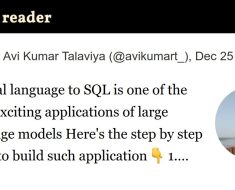While generative AI technology has rapidly advanced in recent years, former Salesforce executive Richard Socher believes that there is still room for improvement. In a Harvard Business Review podcast, Socher discussed how we can level up large language models by pushing them to respond to prompts in code instead of just predicting the next token.
Currently, large language models rely on predicting the next token based on previous data. While these models demonstrate impressive reading comprehension and coding skills, they often suffer from hallucinations, where they produce factual errors as if they were true. This becomes particularly problematic when faced with complex mathematical questions.
Socher provided an example of a question that a large language model might struggle with: “If I gave a baby $5,000 at birth to invest in a no-fee stock index fund, and assuming a certain percentage of average annual returns, how much will they have by age two to five?” Instead of carefully considering the question and performing the necessary calculations, the model would generate text based on similar questions it had encountered before.
To overcome this limitation, Socher proposes “forcing” the model to translate the question into computer code and generate an answer based on that code. By doing so, the model is more likely to provide an accurate response. Socher mentioned that at his AI-powered search engine, You.com, they have been able to translate questions into Python code.
In contrast to the common approach of simply scaling up data and computing power, Socher suggests that programming will play a crucial role in advancing large language models. By teaching these models to code, they will gain a deeper understanding and more versatile problem-solving capabilities. This programming approach will enable them to tackle more complex tasks in the future.
As the competition among large language models intensifies, with OpenAI’s GPT-4 and Google’s Gemini vying for superiority, Socher’s perspective provides a fresh angle on advancing AI capabilities. Instead of solely relying on scaling up data, forcing AI models to code could unlock their full potential and lead to significant advancements in the field.
Frequently Asked Questions (FAQ) on Improving Large Language Models through Coding
Q: What is the challenge with current large language models?
A: Current large language models have limitations in producing accurate responses when faced with complex questions, especially those requiring mathematical calculations. They often suffer from hallucinations, where they generate factual errors as if they were true.
Q: What is the proposed solution to overcome these limitations?
A: Richard Socher proposes “forcing” large language models to translate questions into computer code and generate answers based on that code. By doing so, the models are more likely to provide accurate responses.
Q: How does translating questions into code improve the models?
A: Translating questions into code helps the models gain a deeper understanding of the questions and enables them to perform the necessary calculations. This approach enhances their problem-solving capabilities and increases the likelihood of accurate responses.
Q: Has this approach been implemented in any AI-powered search engine?
A: Yes, at You.com, an AI-powered search engine, they have successfully translated questions into Python code to improve the accuracy of responses.
Q: How does this coding approach differ from the traditional approach of scaling up data and computing power?
A: Socher suggests that teaching large language models to code will be crucial in advancing their capabilities, rather than solely relying on scaling up data. By programming the models, they gain a deeper understanding and more versatile problem-solving abilities for tackling complex tasks in the future.
Q: How does Socher’s perspective stand out in the competition among large language models?
A: Socher’s perspective introduces a fresh angle on advancing AI capabilities. Instead of solely relying on scaling up data, forcing AI models to code could unlock their full potential and lead to significant advancements in the field.
Key Terms/Jargon:
– Generative AI technology: Refers to AI models capable of producing original content by generating new data based on patterns and examples from existing data.
– Language models: AI models specifically designed to generate and understand human language.
– Hallucinations: In the context of AI language models, refers to the production of factual errors as if they were true.
– Token: In language models, a token refers to a segment of text, usually a word or a character.
– Python code: Programming language used by Socher as an example of code translation for improving large language models.
Suggested Related Links:
OpenAI – official website of OpenAI, known for their large language models like GPT-4.
Google – official website of Google, the company behind large language models like Gemini.



